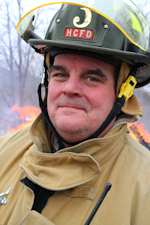FHWorld17: Fitness Expert Says Firefighters Benefit From Simple Movement
SAN DIEGO—To be fit, you don’t need a gym membership, goofy clothing, an iPod and earphones or anything else for that matter, except a will to get up and move.
Milwaukee Fire Department Capt. Jordan Ponder taught a class at Firehouse World on how firefighters can keep fit by just doing routine and ordinary things, but most importantly just getting up and moving. The course was called “Firefighter Safety: Our Greatest Need.”
“In the fire service, what is our most valuable asset?” Ponder asked. “It’s the firefighter and the personnel. It’s all of us. Our greatest concern is firefighter safety.”
Then he asked whose safety is more important, the victim or the firefighter?
“The firefighter,” Ponder said. “It’s always our safety first. It’s part of the risk/benefit analysis.”
Ponder said firefighters are 1,450 percent more likely to be injured than their friends and family.
“Think about all the things we have to do,” he said, rationalizing the startling statistic. It’s not the sensationalism of an active shooter that causes the most injuries and deaths.
“Fifty-four percent of all fireground injuries are slips, strains and sprains,” Ponder said, adding that there are far more injuries caused by overexertion of muscles and ligaments. Refining it just a bit, he added that many of the injuries are shoulder and lumbar back injuries.
“And the statistics have remained unchanged for the last 35 years,” Ponder said.
While the statistics haven’t changed, he said the firefighter can change and that will make the numbers change.
Ponder, who is a 13-year veteran of the fire service and professional body builder assigned to the busiest engine in the state of Wisconsin, said he knows a thing or two about firefighter fitness. In his time as a firefighter, he has learned that firefighters are resistant to change because, “Change implies that there is something wrong with you,” he said. “We need to take that culture and move it forward.”
“Change is incredibly difficult,” Ponder said.
Ponder is a big advocate of having firefighters just do simple movements that replicate what they do at the fireground, like pulling hose or throwing ladders or forcing doors. He pointed out that nowhere in his presentation did he say workout. For many in the fire service, that’s a big turnoff.
Lack of movement causes unwanted weight gain and muscle restrictions, which then trigger a deconditioning cycle because movement causes pain and people become afraid of moving, Ponder said.
And that lack of movement can decrease the serotonin in the body, which causes depression and that is another contributing factor in the deconditioning cycle.
That leads to misuse of muscles, Ponder said. Pain in the knees, for instance, will cause people to misuse their hip and ankle joints to avoid the pain.
Ponder understands that firefighters experience a lot of sitting around time. They sit around the kitchen table solving world problems and catching up with one another, sit for meals, they sit waiting for calls and they sit doing reports. Even training classrooms are set up to promote sitting with tables and chairs.
Ponder said humans are formed in wombs and are inactive and the body has a tendency to want to go back to that resting place as often as possible.
“So what’s the answer, what do we do?” Ponder asked. “This is a crazy concept. Move. That’s it. Move. We need to know how to move. Just find an enjoyable activity, something you like to do.”
He said firefighters need to move in the ways their body must perform during emergency events and they should monitor their activities as it will help them remain active. Even simple, modest activities are helpful, he said.
“People will say ‘I can do that’ and then they’ll start to move a little longer,” Ponder said. “It’s self-generating. We need to get to a place where we can move better to do our jobs better.”
Ponder said there are three types of fitness firefighters need: endurance, to go the extra mile from the response through the overhaul; strength, to lift generators or bodies during rescue; and power, to force a door or rip a crosslay hose from its bed.
“You need to be prepared, be active and be restored,” Ponder said, adding that restoration needs to be part of any exercise regimen.
Too many firefighters get into problems when their hearts get pumping fast to take care of the emergency situation and then the activity stops, but their hearts don’t slow down as quickly. So the heart causes edema in the legs, which creates a situation that can lead to cardiac events, Ponder said, noting that cool down periods after fire activities are important.
Ponder said it’s possible for firefighters to end the 35 years of stagnant statistics and reduce the number of firefighter injuries that can be attributed to strains and exertion.
“You can move this,” Ponder said. “Be dynamic. It’s about learning to move and getting your members to move. Then it’s about moving better. It’s all about forward progress.”

Ed Ballam
Ed Ballam served as associate editor for Firehouse. He is the assistant chief of the Haverhill Corner, N.H. Fire Department, and a National Registered EMT. He is also a Deputy Forest Fire Warden for the New Hampshire Division of Forests and Lands. Professionally, he's been a journalist for over 35 years working for a variety of publications, including employment as managing editor of a national fire service trade journal for more than a decade.






